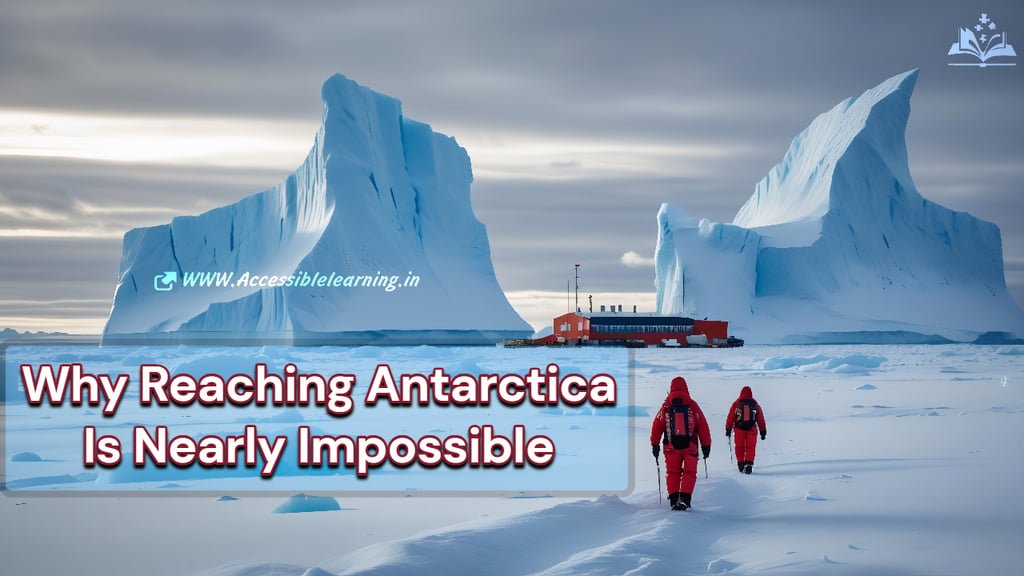
Why Reaching Antarctica Is Nearly Impossible
Antarctica remains one of the most challenging places to reach on Earth due to extreme weather, geographic isolation, and lack of infrastructure. This in-depth article explores the obstacles that make travel to the frozen continent nearly impossible, including historical expeditions, climate impact, hidden mysteries, and future challenges.
ENVIRONMENTDARK SIDEGLOBAL ISSUESAWARE/VIGILANTEDUCATION/KNOWLEDGE
Sachin K Chaurasiya
2/25/20258 min read


Antarctica, the coldest, driest, and most remote continent on Earth, is one of the last frontiers of our planet. It remains largely uninhabited, with only a few thousand scientists and researchers braving its extreme conditions. While the idea of visiting this frozen wilderness is thrilling, reaching Antarctica is incredibly difficult. This article explores the many barriers—both natural and logistical—that make traveling to Antarctica almost impossible for most people.
Extreme Weather Conditions
Antarctica is the coldest place on Earth, with temperatures that can drop as low as -128.6°F (-89.2°C). Even in the summer months (November to March), coastal temperatures barely rise above freezing, while the interior remains bitterly cold. The harsh weather makes travel risky, with blizzards, whiteouts, and sudden temperature drops posing significant threats. Wind speeds can reach over 200 mph (322 km/h), making navigation and survival extremely difficult. Additionally, the lack of natural light for half the year during the winter months adds another level of challenge.
Geographic Isolation
Antarctica is the most remote continent, located at the southernmost point of the planet. It is surrounded by the Southern Ocean, which creates a natural barrier that makes access incredibly challenging. The continent is over 1,000 miles (1,600 km) from the nearest major landmass, meaning travelers must endure long and treacherous journeys either by sea or air. The Southern Ocean is also home to some of the roughest waters in the world, further complicating maritime travel.


Limited Accessibility
By Ship: Most visitors arrive via ice-strengthened ships that depart from Argentina, Chile, New Zealand, or Australia. However, the journey through the Drake Passage—a notoriously rough stretch of ocean—can be dangerous, with towering waves and violent storms. Additionally, icebergs and pack ice present constant navigation challenges.
By Air: Flights to Antarctica are rare and expensive. Only a few airstrips exist, primarily used for scientific research. Strong winds and unpredictable weather frequently cause cancellations, making air travel unreliable. Many runways are made of ice, which requires specialized landing procedures and aircraft.
Lack of Infrastructure
Unlike other continents, Antarctica has no cities, permanent roads, or hotels. The only human presence comes from research stations run by different countries. Transportation within the continent is limited to specially designed vehicles, helicopters, and snowmobiles. There are no commercial flights or regular passenger services, making independent travel virtually impossible. Fuel supplies are limited, and logistics for resupplying stations are complex and costly.
Environmental and Legal Restrictions
The Antarctic Treaty System, signed by multiple nations, strictly regulates human activity on the continent to protect its fragile ecosystem. Tourism is highly restricted, and only a limited number of operators are allowed to bring visitors. Strict environmental guidelines prevent the construction of commercial facilities, and visitors must adhere to protocols that minimize human impact. Additionally, the presence of dangerous wildlife, such as leopard seals and aggressive skuas, can pose risks to travelers.
Historical Expeditions and Challenges
The history of exploration in Antarctica is filled with dramatic stories of survival and tragedy. Famous explorers such as Ernest Shackleton, Robert Falcon Scott, and Roald Amundsen led daring expeditions to uncover Antarctica’s secrets. Shackleton’s Endurance Expedition (1914–1917) remains one of the greatest survival stories in history, as his crew was stranded on ice for months before making an incredible escape. Scott’s ill-fated journey to the South Pole in 1912 ended in disaster when he and his team perished in the freezing conditions. Amundsen, on the other hand, became the first person to reach the South Pole in 1911, using sled dogs and careful planning to succeed where others had failed.
The Role of Antarctica in Global Climate
Antarctica plays a crucial role in regulating the Earth's climate. The continent's vast ice sheets reflect sunlight, helping to cool the planet. Additionally, the Southern Ocean surrounding Antarctica drives major ocean currents that distribute heat across the globe. The Antarctic ice sheets store around 60% of the world's fresh water, and their melting due to climate change is a growing concern. If Antarctica’s ice were to melt completely, global sea levels could rise by more than 200 feet (60 meters), dramatically reshaping coastlines around the world.
Cost of Travel
A trip to Antarctica is prohibitively expensive. Cruises can cost anywhere from $5,000 to $50,000 per person, depending on the length and level of comfort. Private flights or expeditions can cost even more. The high price tag, coupled with logistical challenges, makes it an exclusive destination only for researchers, scientists, and wealthy adventurers. Furthermore, insurance for Antarctic travel is often expensive due to the extreme risks involved.


Health and Safety Risks
Antarctica's extreme environment presents numerous health risks, including frostbite, hypothermia, and altitude sickness (especially in the higher interior regions). Medical facilities are minimal, with only basic clinics at research stations. Any serious medical emergency requires evacuation, which is both difficult and costly, especially during the winter months when the continent is virtually cut off from the rest of the world. The isolation also makes mental health a concern, as extended stays in extreme conditions can lead to psychological stress and seasonal affective disorder (SAD).
Hidden Mysteries of Antarctica
Despite being one of the most studied regions on Earth, Antarctica still holds many secrets. Subglacial lakes, such as Lake Vostok, remain liquid beneath miles of ice, possibly harboring ancient microbial life. The Blood Falls phenomenon, where iron-rich water seeps from glaciers, gives the appearance of a river of blood. Some researchers even speculate about underground ecosystems that have been isolated for millions of years, potentially containing unknown life forms.
The Future of Antarctica
As climate change accelerates, Antarctica is experiencing significant changes. The melting of ice sheets threatens global sea levels, while warming temperatures impact the continent's delicate ecosystem. Additionally, there are ongoing debates about potential mineral and resource exploitation, which remains controversial under the Antarctic Treaty System. Scientists continue to monitor and study Antarctica, as understanding its changes is key to predicting future environmental impacts.


Who perished during Antarctic expeditions?
Captain Robert Falcon Scott (1868–1912) and His Team
Expedition: Terra Nova Expedition (1910–1913)
Cause of Death: Extreme cold, starvation, and exhaustion on the return journey from the South Pole.
Team Members Who Also Died:
Edward Adrian Wilson (Naturalist & Doctor)
Henry Robertson Bowers (Navigator & Lieutenant)
Lawrence Oates (Army Captain, voluntarily walked to his death to help his team)
Edgar Evans (Petty Officer, first to die from injuries and frostbite)
Merz and Loescheke (1903)
Expedition: German Antarctic Expedition (Led by Erich von Drygalski)
Cause of Death: Drowned after falling through sea ice.
Lieutenant Belgrave Ninnis (1887–1913)
Expedition: Australasian Antarctic Expedition (1911–1914) led by Douglas Mawson.
Cause of Death: Fell into a crevasse along with a sled carrying food supplies.
Xavier Mertz (1882–1913)
Expedition: Australasian Antarctic Expedition (1911–1914)
Cause of Death: Starvation and exhaustion while trying to return to base after Ninnis' death. He may have suffered poisoning from consuming the livers of sled dogs, which contain toxic levels of vitamin A.
Henryk Arctowski Expedition Tragedy (1898–1899)
A few members of the Belgian Antarctic Expedition, including Polish scientist Henryk Arctowski, suffered from severe frostbite and illness. While no official members died, crew members were close to death during the first recorded winter spent in Antarctica.
Members of the Shackleton-Rowett Expedition (1921–1922)
Sir Ernest Shackleton (1874–1922) – Died of a heart attack aboard his ship, the Quest, during his fourth expedition.
Dr. Alexander Macklin (Expedition Doctor) noted that Shackleton ignored health warnings and had underlying heart issues.
Carl Anton Larsen Expedition Members (1904)
Some Norwegian whalers who tried to establish a base in South Georgia and Antarctica perished due to extreme cold and storms.
Air and Sea Accidents (1940s–Present)
Several military and research personnel from the U.S., U.K., and other nations have died in plane crashes, shipwrecks, and ice-related accidents while conducting Antarctic research.


FAQs About Reaching Antarctica
Why is it so difficult to reach Antarctica?
Antarctica is extremely remote, covered in thick ice, and surrounded by rough, stormy seas. The continent also experiences some of the harshest weather on Earth, with temperatures dropping as low as -80°C (-112°F) and unpredictable blizzards making travel dangerous. Additionally, there are no commercial flights or regular transport routes to the region.
Can anyone visit Antarctica?
Yes, but under strict conditions. Most people visit as part of guided tours or scientific research missions. Tourists can reach Antarctica via specialized cruises or chartered flights, but independent travel is nearly impossible due to environmental regulations, extreme conditions, and a lack of infrastructure.
Has anyone ever died trying to reach Antarctica?
Yes, many explorers have perished while attempting to explore or cross Antarctica. Notable figures include Captain Robert Falcon Scott and his team, who died in 1912 after reaching the South Pole. Others, such as Belgrave Ninnis and Xavier Mertz, perished due to accidents and starvation. Even in modern times, pilots, researchers, and sailors have lost their lives due to extreme weather and ice-related hazards.
How do scientists survive in Antarctica?
Scientists live in specialized research stations equipped with insulated buildings, advanced heating systems, and stored food supplies. They wear extreme cold-weather gear, follow strict survival protocols, and rely on supply deliveries from support ships or aircraft.
Is there an airport in Antarctica?
Yes, there are several airstrips but no commercial airports. Research stations operate ice runways and gravel airstrips for supply missions. The most used runways include McMurdo Station’s Phoenix Airfield (USA) and Union Glacier Camp (Chile, private use for tourism). However, harsh weather can make landing nearly impossible for long periods.
Why is Antarctica important for global climate?
Antarctica plays a crucial role in regulating Earth’s climate. Its massive ice sheets reflect sunlight, keeping global temperatures in check. The continent also stores about 70% of the world’s freshwater, and its melting ice due to climate change could significantly impact global sea levels.
What mysteries does Antarctica hold?
Hidden subglacial lakes (like Lake Vostok) that may contain unknown life forms.
Undiscovered mountain ranges buried under the ice.
Meteorites and fossils that reveal Earth’s ancient history.
Theories of lost civilizations (although no proof exists).
Is there a government in Antarctica?
No, Antarctica does not belong to any one country. Instead, it is governed by the Antarctic Treaty (signed by over 50 nations), which prohibits military activities, territorial claims, and resource exploitation. The continent is reserved for peaceful scientific research and environmental protection.
Can I live in Antarctica permanently?
No, Antarctica has no permanent human population. Scientists, researchers, and support staff stay temporarily in research stations, typically for a few months to a year. The extreme cold, isolation, and harsh conditions make permanent settlement impossible.
What is the future of Antarctica?
With climate change affecting the ice sheets, Antarctica's future is uncertain. Scientists predict rising global sea levels if Antarctic ice continues melting. There is also growing interest in its natural resources, leading to debates about environmental protection versus economic exploration. The Antarctic Treaty protects the continent, but future policies may change as global demand for resources increases.


While Antarctica remains one of the most breathtaking and mysterious places on Earth, reaching it is almost impossible for the average person. Harsh weather, geographic isolation, lack of infrastructure, strict regulations, high costs, and significant safety risks make it one of the most challenging places to visit. For most, experiencing Antarctica will remain a dream best enjoyed through documentaries, books, and the incredible images captured by scientists and explorers.
Subscribe to our newsletter
All © Copyright reserved by Accessible-Learning
| Terms & Conditions
Knowledge is power. Learn with Us. 📚


